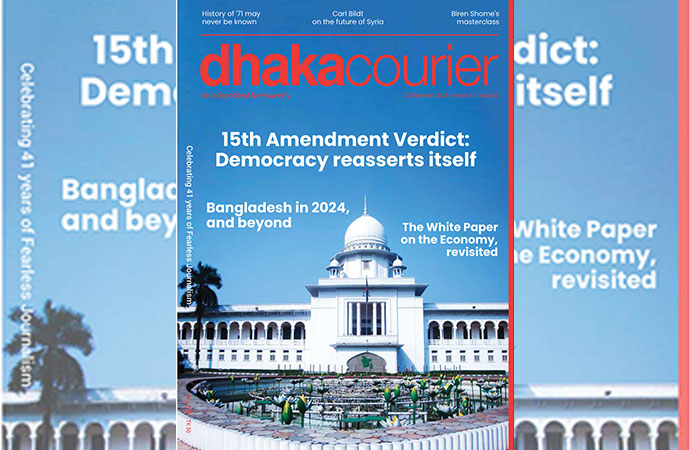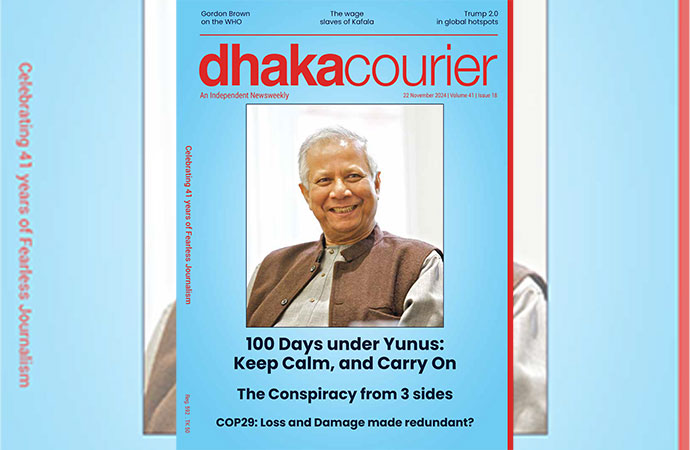Reportage

The fire-panic that hit the capital this week laid bare, with disarming clarity, the sheer vulnerability that the residents of Dhaka are forced to live with as a part of their daily existence. It all started with a fierce blaze in upmarket Banani's FR Tower on March 28, that quickly spread through the upper floors of the building and resulted in the deaths of 26 people. Coming barely a month on from the deadly inferno at Chawkbazar in the Old Town that took 71 lives, it served to put the entire city on edge.
When the very next morning, a Friday, it emerged that the long-standing kitchen market adjoining the DCC Market in Gulshan-1 was on fire, it was enough to push some of the faint-hearted right over. Fortunately, there were no casualties. Apart from completely gutting 291 shops in the kitchen market, the fire that started in an empty market around 5.45am partially damaged another 37 temporary businesses selling various items including household and daily goods, fruits, baby food, imported food products, clothing, and crockeries. Just the 62 shops that had been relocated at a temporary shed after a previous fire in January 2017 fire were left unharmed.
Suddenly news of fires started popping out of every corner. That Friday saw another fire doused before it could do much harm at a residential building in Banani. There was another one in Dhanmandi. Separate fires that weekend gutted some houses, shops and factories in Gazipur, just outside the capital. It was all extremely unnerving, and knowing the uphill battle our rescue services face in such emergencies didn't exactly inspire confidence.
If the Chawkbazar fire had rendered some of the business practices prevalent in Old Dhaka untenable, FR Tower came along it would seem, to serve the same purpose for the new parts of town, the ones that had witnessed the bulk of the unregulated, haphazard urbanisation that typifies Dhaka. It was one of the deadliest fires ever to take place in a high-rise building in Bangladesh. The incident has raised many questions regarding fire safety procedures in Dhaka's high-rise buildings. When the fire broke out, the building's emergency exits were locked, and there were only two fire exits and no sprinklers.
"It was not possible to see anything as there was a dark wall of smoke everywhere. Within 10 minutes the smoke spread throughout the building making it difficult for people to escape." Exhausted and terrified, Hasina Parvin, Credit Control Manager of Aamra Networks Limited, housed on the 17th floor of the 22-storey Faruk Rupayan (FR) Tower in the capital's Kemal Ataturk Avenue, said this while narrating her harrowing experience of Thursday's devastating fire incident that left 26 people dead.
The 39-year-old mother of two daughters escaped the horrific fire that broke out on the 6th floor of the building around 12:45 pm.
"We were at a departmental meeting at that time. Suddenly, we saw through the window huge black smokes bellowing up and noticed a fire at our building. Instantly, me along with other colleagues got out of the office and rushed to the staircase. We heard people screaming and saw smoke filling up the staircase," she said.
"Just within 10 minutes, the smoke spread throughout the building and we reached the rooftop. Around 50 people, including me, managed to reach the rooftop. But a little later, it was impossible to stay there because of the smoke," she said.
Parvin and some of her colleagues ran towards the rooftop as it was impossible to get down through the stairs due to the huge dark smoke. After reaching the rooftop, they jumped to the adjacent building, Ahmed Tower, and got down to the ground.
Parvin narrated she saw some people jumping off the building breaking open the windowpanes. "Too late to make it to the rooftop for an easier escape, they tried to escape through the windows of the building and some of them fell down."
She also said people used two ways to escape -- some tried to go to the rooftop while some others broke the windowpanes to get to Ahmed Tower, the next building.
"Till 1:00 pm, people were able to make it to the rooftop. But after that, the staircase become too hazy for people to make it through," she said.
Parvin said there were 65 employees on their floor but four of those could not manage to escape. "Later, they were rescued by firefighters around 3:45 pm and taken to Apollo Hospital."
She, however, said there was no emergency fire exit in the 22-storey building that houses dozens of offices. "I've been working in this building for around seven years and had the same experience during an earthquake several years back...many panicked people were injured while getting down," she added.
Sushanta Roy, who is now undergoing treatment at Apollo Hospital, told our sister newsagency UNB, "Thanks to the Almighty that I'm alive. When I got trapped on the 17th floor, I thought it's over, I wouldn't survive. We were unable to breathe properly due to suffocation and black smoke."
"We broke open the glass wall and screamed for help. Once, I thought would jump off the building, but saw several people fell down while climbing down holding cables," he said.
Later, the firefighters rescued me and put me down through the ladder, he added.
While visiting the spot in the morning, Housing and Public Works Minister SM Rezaul Karim said the FR Tower was built violating rules. "Permission was given only for an 18-storey building, but a 22-story building was constructed illegally."
He said Rajuk approved the 18-storey FR Tower in 1996. "But, the building owner submitted the copy of a 22-storey building design in 2005. After investigation, it was found they submitted an improper design without Rajuk's approval. The building was constructed violating the (original) design."
After Thursday's fire, Rajuk formed a committee to investigate how the four additional floors were built and whether the building had fire-safety measures. Built on an eight-katha plot, each of its floors has 6,000 square feet of space for commercial purposes. The building houses a restaurant, a coffee shop, a branch of state-run Pubali Bank, a buying house, a freight-forwarding company, and many other firms.
Landowner SMHI Faruk and the owner of the allegedly illegal portion Tasvir Ul Islam have been arrested in the case over FR Tower fire, but developer Rupayan Group Chairman Liaquat Ali Khan Mukul remains elusive. Metropolitan Detective Branch (DB) of police sources say Liaquat is currently in Singapore. To avoid getting arrested, Liaquat reportedly fled to Singapore the day after the devastating fire broke out.
The arrests struck some as a bit of a red herring, since the fire neither started in nor spread to the top four floors that are said to have been built illegally. It is not as if the building used to have a fire exit that was removed to make way for the top four floors. Besides, how can buildings be built and stand for years illegally without regulators being complicit somehow? Yet where is the censure of the officials involved?
The approval of a building plan needs clearance for land use, non-objection certificate (NOC) from Civil Aviation Authority of Bangladesh (not applicable for the areas where there is no movement of aircraft), NOC from law enforcement agencies for constructing buildings near Key Point Installations (KPIs) and NOC from the Fire Service (only for the construction of over 10-storey buildings). When so many checks are missed, it is time to admit that the issue is a more nefarious one: the checks were not missed. They were systematically averted.
All are complicit
The outpouring of concern and condemnation may well strike one as closing the door after the horse has bolted. And in a sense it is, at least for those who have already lost their lives. It is all very well for Rajuk to appear on the scene and declare a building's papers are not in order or it didn't have the correct set of permissions, but what use is it to do so only after your attention has been brought to it by the tragic scenes of people falling out of its windows to their deaths, several floors below?
The truth is years of neglect have turned Dhaka into a minefield of dangers lurking in almost every corner. And while the entire population of the city is at some level responsible for the present situation, whether we like it or not, the buck stops with those either elected or appointed to govern the city.
Around 66 percent buildings in capital Dhaka and its adjoining areas under the jurisdiction of Rajdhani Unnayan Kartripakkha (Rajuk) have been constructed in an unplanned way, said Housing and Public Works Minister SM Rezaul Karim.
"Of the buildings, some have no approval at all while some others flouted approved designs," he told UNB in an interview citing a recent survey report.
About flouting the building designs for lack of monitoring, Rezaul said this will not happen anymore. He also said a digital monitoring system will be introduced to check the violation of the building code and approved designs.
About malpractices in Rajuk, the minister said he will bring a radical change in Dhaka's development regulator. He also said they are thinking about bifurcating Rajuk to bring dynamism into its activities. "It's impossible to manage upto Savar, Manikganj and Narayanganj from Dhaka. Rajuk will be divided into two parts like two city corporations if the prime minister gives her consent to it."
Living with the threat
According to the Fire Service and Civil Defence force's surveys, most shopping malls and markets in the capital have been running without mandatory safety measures for years, posing a serious threat to public safety. In 2017, Fire Service and Civil Defence identified 622 shopping malls and markets in Dhaka as "extremely risky" and 678 others as "risky" after conducting a survey on 1,305 commercial establishments from October to November 2017. Only five buildings were marked as safe.
The extremely risky (with no fire-safety necessities) or risky (with some fire-safety measures installed) markets and malls have been in operation for years without fire-safety clearance and licence. According to Bangladesh National Building Code (BNBC) 2006 and Fire prevention Act 2003, a market will have to keep sufficient fire extinguishers (an extinguisher for every 550 square feet) and sufficient staircases.
A market should have sufficient reserve water, a diesel pump, an electrical pump and a jockey pump, arrangement for emergency lightings, smoke and heat detector, fire alarm system and sprinkler. Also, it will have to have fire safety and evacuation plan, emergency exists with smoke-proof stairwells. But you'll be hard pressed to find a single market in Dhaka that satisfies all these conditions. Or even most of them.
The number of fires reported in the country, as recorded by the FSCD, has also been rising. From 16,858 in 2016, the number of such incidents rose to 18,105 in 2017, and then on to 19,642 in 2018.
Thirty-nine percent of the total reported fire incidents across the country were sparked by electric short-circuits, while 19 percent were caused by gas and 15 percent from cigarette buds, Dataful, a data journalism initiative, reported.
Talking to UNB this week, noted construction and earthquake expert Prof Jamilur Reza Choudhury, urban expert Prof Nazrul Islam, architect and urban planner Iqbal Habib and the Buet Civil Engineering department's Prof Mehedi Ahmed Ansari attributed the rise in fire incidents to unplanned urbanisation, violation of building codes, carelessness, increased use of gas cylinders and lack of supervision by authorities.
Iqbal Habib noted now most of the garment factories are safe and workers-friendly as the Accord and Alliance, the two western buyers' platforms, created huge pressure on the factory owners to ensure safety and compliance after the Rana Plaza tragedy in 2013. "We need a body like Accord to ensure safety," he said, voicing a thought that will have crossed a number of minds over the past week.
Indeed, the EU released a statement in the wake of the FR Tower blaze, that sounded almost suggestive in this regard. The statement encouraged the government of Bangladesh to take policy measures in economic sectors in Bangladesh, including in the building and ready-made garments sector, to ensure safety in the workplace. It said the EU attached high importance to workplace safety and noted how it had been working since 2013 with "the authorities of Bangladesh to improve workplace safety in the readymade garment sector."
Of course, garment owners themselves have been getting very vocal wanting Accord/Alliance to wrap up their activities, since having them around eats into their profitability. A court ruling is due very soon on whether they should or not. If good sense prevails, it will reflect that their work here is not done yet.

























Leave a Comment
Recent Posts
Curtain rises on 6th National ...
The month-long '6th National Sculpture Exhibition 2024', organ ...
Thailand's sea nomads strive t ...
When Hook was a child, he started his days by jumping off the boat tha ...
Liliums grown in Bagerhat show surprising promise fo ..
Bangladesh’s three divisions brace for rain
Prioritise reconstruction of Gaza, West Bank, Lebano ..
In support of the vision set forth by the CA